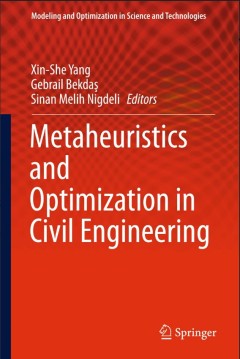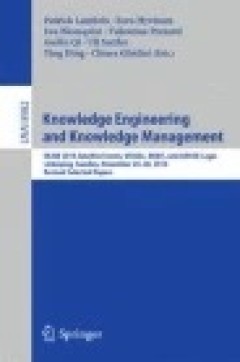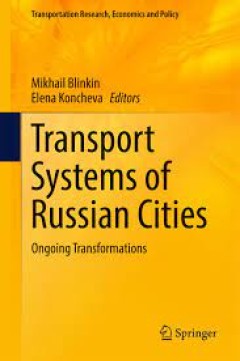Filter by

Modern Nonparametric, Robust and Multivariate Methods
Written by leading experts in the field, this edited volume brings together the latest findings in the area of nonparametric, robust and multivariate statistical methods. The individual contributions cover a wide variety of topics ranging from univariate nonparametric methods to robust methods for complex data structures. Some examples from statistical signal processing are also given. The volu…
- Edition
- 1
- ISBN/ISSN
- 978-3-319-22403-9
- Collation
- xx, 506
- Series Title
- -
- Call Number
- -

Modified Nucleic Acids
This book spans diverse aspects of modified nucleic acids, from chemical synthesis and spectroscopy to in vivo applications, and highlights studies on chemical modifications of the backbone and nucleobases. Topics discussed include fluorescent pyrimidine and purine analogs, enzymatic approaches to the preparation of modified nucleic acids, emission and electron paramagnetic resonance (EPR) spec…
- Edition
- 1
- ISBN/ISSN
- 1869-2486
- Collation
- X, 276
- Series Title
- Nucleic Acids and Molecular Biology
- Call Number
- -

Instability and Control of Massively Separated Flows
This book contains the outcome of the international meeting on instability, control and noise generated by massive flow separation that was organized at the Monash Center, in Prato, Italy, September 4-6, 2013. The meeting served as the final review of the EU-FP7 Instability and Control of Massively Separated Flows Marie Curie travel grant and was supported by the European Office of Aerospace…
- Edition
- -
- ISBN/ISSN
- 978-3-319-06259-4
- Collation
- XXXIX, 254
- Series Title
- -
- Call Number
- 621 THE i

Instability in Flow Boiling in Microchannels
This Brief addresses the phenomena of instability in flow boiling in microchannels occurring in high heat flux electronic cooling. A companion edition in the SpringerBrief Subseries on Thermal Engineering and Applied Science to “Critical Heat Flux in Flow Boiling in Microchannels,” and "Heat Transfer and Pressure Drop in Flow Boiling in Microchannels,"by the same author team, this volume is…
- Edition
- -
- ISBN/ISSN
- 978-3-319-23430-4
- Collation
- VIII, 55
- Series Title
- -
- Call Number
- 621 SAH i

Method of Dimensionality Reduction in Contact Mechanics and Friction
This book describes for the first time a simulation method for the fast calculation of contact properties and friction between rough surfaces in a complete form. In contrast to existing simulation methods, the method of dimensionality reduction (MDR) is based on the exact mapping of various types of three-dimensional contact problems onto contacts of one-dimensional foundations. Within the conf…
- Edition
- 1
- ISBN/ISSN
- 978-3-642-53875-9
- Collation
- XVII, 265
- Series Title
- -
- Call Number
- -

Metal Response in Cupriavidus metallidurans:Volume I: From Habitats to Genes …
This book is the first volume of a two-volume set summarizing 40 years of key research findings directly related to metal-resistant Cupriavidus/Ralstonia (Betaproteobacteria). In this first volume, the historical and geographical context of these bacteria, which are mostly found in industrial and polluted environments linked to zinc and other non-ferrous metallurgy, is sketched to illustrate th…
- Edition
- 1
- ISBN/ISSN
- 978-3-319-20593-9
- Collation
- IX, 89
- Series Title
- SpringerBriefs in Molecular Science
- Call Number
- -

Metaheuristics and Optimization in Civil Engineering
This timely book deals with a current topic, i.e. the applications of metaheuristic algorithms, with a primary focus on optimization problems in civil engineering. The first chapter offers a concise overview of different kinds of metaheuristic algorithms, explaining their advantages in solving complex engineering problems that cannot be effectively tackled by traditional methods, and citing the…
- Edition
- 1
- ISBN/ISSN
- 978-3-319-26243-7
- Collation
- XI, 302
- Series Title
- Modeling and Optimization in Science and Technologies
- Call Number
- -

Knowledge Engineering and Knowledge Management: EKAW 2014 Satellite Events, V…
This book constitutes the refereed proceedings of Satellite Events held at the 19th International Conference on Knowledge Engineering and Knowledge Management, EKAW 2014 in November 2014. EKAW 2014 hosted three satellite workshops: VISUAL 2014, International Workshop on Visualizations and User Interfaces for Knowledge Engineering and Linked Data Analytics, EKM1, the First International Workshop…
- Edition
- -
- ISBN/ISSN
- 978-3-319-17966-7
- Collation
- -
- Series Title
- -
- Call Number
- -

Axiomatic Design in Large Systems : Complex Products, Buildings and Manufactu…
This book provides a synthesis of recent developments in Axiomatic Design theory and its application in large complex systems. Introductory chapters provide concise tutorial materials for graduate students and new practitioners, presenting the fundamentals of Axiomatic Design and relating its key concepts to those of model-based systems engineering. A mathematical exposition of design axioms is…
- Edition
- -
- ISBN/ISSN
- 978-3-319-32388-6
- Collation
- XXI, 322
- Series Title
- -
- Call Number
- 690

Transport Systems of Russian Cities
This volume discusses post-socialist urban transport functioning and development in Russia, within the context of the country’s recent transition towards a market economy. Over the past twenty-five years, urban transport in Russia has undergone serious transformations, prompted by the transitioning economy. Yet, the lack of readily available statistical data has led to a gap in the inclusion …
- Edition
- 1
- ISBN/ISSN
- 978-3-319-47800-5
- Collation
- XIV, 299
- Series Title
- Transportation Research, Economics and Policy
- Call Number
- -
 Computer Science, Information & General Works
Computer Science, Information & General Works  Philosophy & Psychology
Philosophy & Psychology  Religion
Religion  Social Sciences
Social Sciences  Language
Language  Pure Science
Pure Science  Applied Sciences
Applied Sciences  Art & Recreation
Art & Recreation  Literature
Literature  History & Geography
History & Geography